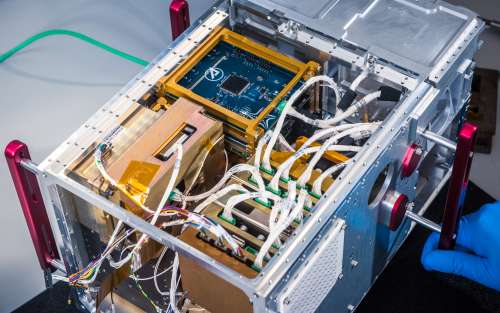Space-based assets play an increasingly vital role in national security, global communications and critical infrastructure. As a result, there is real risk of cyberattacks on these assets, and related assets such as ground stations and data relay systems. Robust cybersecurity measures are essential to protect both space and ground-based assets from threats, ensure data integrity and safeguard operations.
The Aerospace Corporation is uniquely positioned for space cybersecurity research, risk assessment and prototyping due to its decades of experience working on space and ground-based segments and the connecting links between them. This holistic approach allows Aerospace to address vulnerabilities across the entire spectrum of space systems, ensuring that cybersecurity solutions are integrated rather than isolated by segment.
By bridging ground and space cybersecurity, Aerospace can innovate and test more resilient solutions that account for the complex interactions and dependencies between terrestrial and space-based systems. Aerospace’s specialized expertise and long-term partnership with the U.S. government, as well as with international partners, make it ideally suited to tackle emerging cybersecurity threats in the rapidly evolving space domain.
“Space-cyber threats are dynamic, indiscriminate and always on, and the international allied space community is only as strong as its weakest link,” said Jim Myers, senior vice president of Aerospace’s Civil Systems Group. “The price of security is continuous vigilance, information-sharing and collaboration to integrate end-to-end resilience and rapidly and continuously introduce game-changing new cyber defense technologies into the evolving ecosystems we are building with our allies and partners in space.”
SpaceCOP’s Stellar Performance
Aerospace recently demonstrated the value of placing cyber intrusion detection capabilities onboard satellites as part of the Cybersecurity Space Mission Assurance Experiments (Cyber SMAX) project, led by the U.S. Government. The project sought on-board intrusion detection technology to pilot and prove the concept in space.
Among the payloads aboard Slingshot-1, a 12U CubeSat launched by Aerospace in 2022 hosting multiple payloads requiring on-orbit testing for evolution and maturity, was Aerospace’s “Starshield” prototype intrusion detection system, which successfully proved its ability to identify suspicious activity and anomalies on space-based systems in real-world conditions.

Building upon the prototype, Aerospace improved and enhanced its technology to identify and address a wide variety of simulated cyberattacks using novel sources of cyber telemetry, most of which are not available in typical satellite telemetry downlink channels. Renamed SpaceCOP, the new prototype used a combination of heuristics and machine learning to detect simulated anomalies and alert operators, extending its capabilities beyond simply recognizing malicious commands. It was then deployed on orbit for testing through Cyber SMAX.
The results of the experiment were nothing short of spectacular. SpaceCOP proved to be a remarkably effective tool for detecting cyber threats, identifying and flagging suspicious activity in realtime, including subtle anomalies that might otherwise go undetected.
“SpaceCOP used several novel sources of cyber telemetry onboard a satellite, most of which are not available in a typical satellite telemetry downlink channel,” said Nick Cohen, Principal Engineer/Scientist for Aerospace’s Cybersecurity and Advanced Platforms division. “This work proves the effectiveness of adding cyber defenses to a space vehicle and will help protect space assets from cyber adversaries in the future.”
To that end, SpaceCOP’s success has inspired NASA, one of the U.S. space agencies participating in the Cyber SMAX exercise, to seek transition partners for the technology.
Enter DARS
Another Aerospace prototype, the Detection and Reporting System (DARS), is demonstrating the potential to revolutionize space cybersecurity by providing early indications of cyber security intrusions alongside other potential space domain threats, enabling space operators and defenders to respond nearly in realtime, before spacecraft, space systems or missions are compromised.
This advanced system can also provide early indications of other potential dangers such as GPS interference and spoofing, command receiver interference, and optical threats such as “lasing” events. By applying machine learning techniques to spacecraft telemetry, DARS can offer critical situational awareness of threat environments and the status of large satellite constellations.
The capabilities of DARS have been successfully demonstrated in space as part of the NOAA-20 and NOAA-21 missions within the Joint Polar Satellite System (JPSS) program between NASA and NOAA. Aerospace’s team supporting these missions brought together experts from various fields, including spacecraft subsystems, space weather, optical and microwave instruments, data scientists and software engineers. This diverse team trained DARS models on JPSS satellite data, enabling the tool to identify anomalies and characterize them with precision.
Currently, DARS models are being fine-tuned using telemetry from NOAA-21 (previously designated as JPSS-2). Additionally, Aerospace is actively working to advance DARS’s capabilities even further. The next step in its development involves predicting hardware failures, which will provide an additional layer of protection for space-based assets and enable operators to take proactive measures to prevent potential issues. This ongoing effort highlights Aerospace’s commitment to improving the effectiveness and reliability of DARS, ultimately enhancing the safety and security of space operations.
“Even civil and commercial space systems are increasingly at risk of being compromised via space-cyber means in today’s threat environment,” said Dr. Thomas Kashangaki, Aerospace Assistant Principal Director for Systems Integration and Protection. “Innovations like DARS offer peace of mind by having protections immediately available onboard space systems, preserving the integrity of critical missions, technology and data.”
Building a More Secure Future
As the world’s reliance on space-based technologies continues to grow, so does the need for robust space cybersecurity measures, as even a single breach can have catastrophic consequences not only for individual organizations but also for global security and economic stability. Furthermore, with space becoming increasingly accessible to private and public entities, the volume of data transmitted and processed in orbit has surged, creating more potential points of vulnerability.
Identifying and mitigating space threats remains a high-stakes, time-sensitive task. Until recently, satellite operators were reliant upon on specialized hardware or software to identify dangers or monitor system health indicators, but this approach could be slow and resource intensive, making it difficult to detect anomalies or respond quickly to emerging threats.
With pioneering prototypes including SpaceCOP and DARS, Aerospace is staying ahead of an ever-evolving threat landscape. By breaking revolutionary new ground in space cybersecurity, Aerospace is helping to ensure the continued safe and secure operation of critical infrastructure, protecting sensitive data and preserving global trust in this vital sector.

